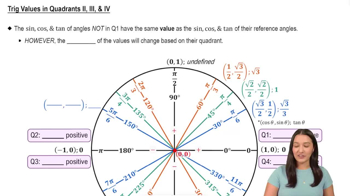Table of contents
- 0. Review of College Algebra4h 43m
- 1. Measuring Angles39m
- 2. Trigonometric Functions on Right Triangles2h 5m
- 3. Unit Circle1h 19m
- 4. Graphing Trigonometric Functions1h 19m
- 5. Inverse Trigonometric Functions and Basic Trigonometric Equations1h 41m
- 6. Trigonometric Identities and More Equations2h 34m
- 7. Non-Right Triangles1h 38m
- 8. Vectors2h 25m
- 9. Polar Equations2h 5m
- 10. Parametric Equations1h 6m
- 11. Graphing Complex Numbers1h 7m
3. Unit Circle
Reference Angles
Problem 6
Textbook Question
Concept Check Match each angle in Column I with its reference angle in Column II. Choices may be used once, more than once, or not at all. See Example 1. I. II. 5. A. 45° 6. 212° B. 60° 7. C. 82° 8. D. 30° 9. E. 38° 10. F. 32°
 Verified step by step guidance
Verified step by step guidance1
Step 1: Understand that a reference angle is the smallest angle that a given angle makes with the x-axis. It is always positive and less than or equal to 90°.
Step 2: For an angle in standard position, determine which quadrant it lies in. For example, 212° is in the third quadrant.
Step 3: Calculate the reference angle for an angle in the third quadrant by subtracting 180° from the given angle. For 212°, compute 212° - 180°.
Step 4: Match the calculated reference angle with the options provided in Column II.
Step 5: Repeat the process for any other angles given in Column I, ensuring to identify the correct quadrant and use the appropriate formula to find the reference angle.
Recommended similar problem, with video answer:
 Verified Solution
Verified SolutionThis video solution was recommended by our tutors as helpful for the problem above
Video duration:
1mPlay a video:
Was this helpful?
Key Concepts
Here are the essential concepts you must grasp in order to answer the question correctly.
Reference Angle
A reference angle is the acute angle formed by the terminal side of an angle in standard position and the x-axis. It is always measured as a positive angle and is used to simplify the analysis of angles in different quadrants. For example, the reference angle for 212° is found by subtracting it from 360° or determining its equivalent acute angle.
Recommended video:

Reference Angles on the Unit Circle
Quadrants of the Unit Circle
The unit circle is divided into four quadrants, each representing a range of angles. The first quadrant contains angles from 0° to 90°, the second from 90° to 180°, the third from 180° to 270°, and the fourth from 270° to 360°. Understanding which quadrant an angle lies in helps in determining its reference angle and associated trigonometric values.
Recommended video:

Introduction to the Unit Circle
Angle Measurement
Angles can be measured in degrees or radians, with degrees being the more common unit in basic trigonometry. A full rotation is 360°, and angles can be positive (counterclockwise) or negative (clockwise). Recognizing how to convert between degrees and radians is essential for solving problems involving angles and their reference angles.
Recommended video:

Reference Angles on the Unit Circle

 5:31m
5:31mWatch next
Master Reference Angles on the Unit Circle with a bite sized video explanation from Callie Rethman
Start learningRelated Videos
Related Practice






















